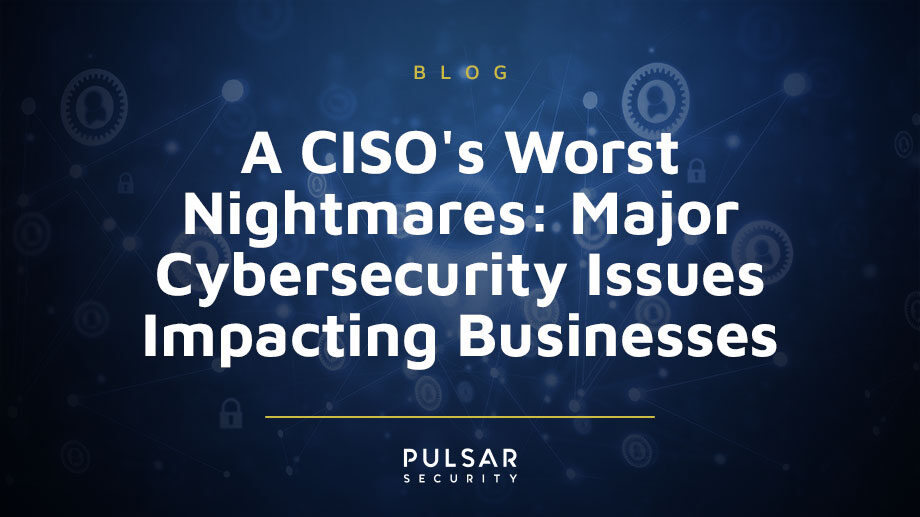A CISO’s Worst Nightmares: Major Cybersecurity Issues Impacting Businesses
The role of a Chief Information Security Officer (CISO) is increasingly demanding in today's digital landscape. With the rise in complex and frequent cyber threats, the CISO is tasked with mitigating imminent dangers from internal vulnerabilities, data leakages, and the much-feared ransomware onslaught. Concurrently, they are also responsible for spearheading strategies for safeguarding digital infrastructure, thwarting cyber intrusions, and implementing cutting-edge cybersecurity protocols like the Zero Trust model.
The intensity of a CISO role is palpable. Survey results from 800 CISOs across the US and UK revealed that 88% are under immense stress, half are grappling with mental health challenges, and a significant one-third have even encountered physical health complications due to stress. It's a high-stakes role with immense pressure.
The anxiety that CISOs experience is completely justifiable. The repercussions of data infringements are multifaceted, where certain occurrences land on the most significant data breaches list due to the sheer volume of affected users. Other incidents gain media attention due to the compromised data's financial implications or confidential nature.
When you tally up the outcomes of these data violations, it's astonishing that the contemporary CISO manages to find any rest.
The security dilemma – who owns organizational security?
Perhaps the most significant conundrum might be who owns organizational security. At first glance, this appears to be a straightforward issue to resolve, but the current landscape has blurred the lines.
In the past, assessing potential collaborators involved auditing the organization, not the platform. However, ambiguity about who should bear the ultimate accountability regarding enterprise security poses a significant challenge.
While the CISO may be a company's security custodian, they do not directly execute the security protocols. In reality, the developers or project managers are at the forefront of implementing these security measures. The developer ecosystem is experiencing a significant expansion, particularly with the increasing adoption of low-code and no-code applications. These platforms are transforming the way security measures are implemented, adding another layer of complexity to the role of a CISO.
Organizations often stumble when differentiating between developers working in this domain and those engaged in a full-stack setting. This disparity can lead to the introduction of security vulnerabilities, which undoubtedly adds to contemporary CISOs' burden. Ensuring uniformity in the treatment and expectations of all developers, regardless of their specific work environment, is crucial in maintaining robust security protocols. This is a key consideration for any CISO aiming to minimize potential security risks.
Challenges in managing access controls
Access control is another critical aspect of security that demands scrutiny, especially regarding employees joining, transitioning within, or leaving the organization.
The presence of a diverse group of developers further complicates the situation. This includes experienced developers and those without formal training, often called citizen developers, who leverage low-code and no-code platforms. Such a mix presents a myriad of potential security challenges.
In addition, the comprehensive digital environment is another area of worry. With a network of applications encompassing third-party software and those developed in-house, deciphering who holds which permissions can be a puzzle. Add to this the unpredictable human factor, and it's a perfect storm for sleepless nights.
Nevertheless, this is not to imply that employees are inherently harmful. However, human beings are susceptible to errors or may inadvertently expose the organization to security threats through seemingly innocuous actions like downloading data onto a spreadsheet. While not intentionally harmful, such actions can indeed pose significant risks. And yes, there are instances where malevolent intent comes into play. It's a complex landscape that requires constant vigilance and proactive management.
Managing identities and authentication problems
CISOs also need to consider the implications of machine and digital identities. These identities are not directly linked to a human user but represent automated processes or applications. This situation raises significant concerns and can result in authentication and data flow management difficulties.
There's also the risk of machine identity creep. In this scenario, the identity may initially seem like a valid user, but it progressively acquires more access privileges. Eventually, this becomes a daunting prospect for CISOs, adding another layer of complexity to their role.
The primary responsibility of a CISO is to ascertain that an organization's security measures and overall security stance are robust enough to protect it. This sounds straightforward, but given the myriad of current security concerns, it's hardly surprising that CISOs often find themselves wrestling with insomnia.
Vulnerable supply chains
A CISO can orchestrate excellent cybersecurity tactics, utilize state-of-the-art tools, and lead a team of exceptional individuals who consistently enlighten the workforce about cyber vigilance. However, all these efforts can be futile if service providers linked to their network neglect to maintain equivalent security standards.
Adversaries will exploit any opportunity to infiltrate the systems of contractors, suppliers, vendors, and other providers by targeting the most vulnerable points in the network. It's a complex landscape that requires a holistic approach to security.
Breaches in the supply chain, or via third-party entities, often serve as a gateway to interconnected networks. Yet, for many businesses, connections with other vendors or service providers are essential for seamless operations. As a result, this situation can leave CISOs feeling incapacitated and defenseless, as they often have limited control over mitigating risks associated with subpar cybersecurity practices. Sometimes, a company's data, stored at an offsite location, could become a potential target for unauthorized access and pose significant risks.
An undisciplined and unaware younger workforce
Safeguarding the organization from cyber threats is a collective responsibility. While the CISO is the head of the security infrastructure, their role extends beyond their immediate duties and team. They are accountable for the entire workforce and any external parties linked to the company's network. Employees who lack discipline, cybersecurity education, and awareness often become the primary contributors to cyber incidents within the organization.
Interestingly, contrary to the stereotype of technologically challenged older employees, numerous studies suggest that the younger workforce is often responsible for a significant portion of cyber incidents. Their primary vulnerability stems from inadequate cybersecurity practices, which can manifest in various forms, such as utilizing insecure passwords, reusing the same password across multiple devices, allowing friends or family to use work devices, or even clicking on dubious links in unverified emails. Millennial and Gen Z generations are reportedly twice as likely or more likely to engage in risky cybersecurity behaviors.
Data breaches are increasing in sophistication and intensity
One of the most pressing issues CISOs grapple with daily is the omnipresent threat of cyberattacks. These digital assaults have emerged as some of the most potent security risks across all industries globally.
No sector is immune to these cyber threats, and what's more concerning is the escalating complexity of the attacks. The sophistication of these threats is on a constant upward trajectory, adding to the challenges CISOs face in their quest to safeguard their organizations.
The fear of failure
The sections above have touched on the daunting challenges and nightmares that CISOs face in their roles. Unfortunately, an underlying fear factor often goes unspoken: the fear of failing oneself, disappointing the team, leaving the organization vulnerable, and, ultimately, the potential loss of employment. For CISOs, there's a narrow margin for error, and leniency is seldom granted. It's no surprise, then, that CISOs are grappling with a persistent and immense level of stress.
In the year 2023, the World Economic Forum, for the first time, placed cybercrime and cybersecurity among the top ten global risks over both short-term (2-year) and long-term (10-year) periods. Research conducted by ZDNET also revealed that the average tenure of a CISO within an organization is a mere 26 months. Upon further investigation into the reasons behind this relatively short duration, ZDNET discovered that, in most instances, it's attributed to elevated stress levels, burnout, and tension in the workplace. An overwhelming majority of CISO executives interviewed (88%) reported experiencing high-stress levels, leading to physical and associated mental health issues.
Collaborating with cybersecurity firms to address these challenges
CISOs often strive tirelessly to secure their organizations, but the high levels of stress and burnout may hinder them from achieving all their cybersecurity objectives. Fortunately, collaboration with established cybersecurity firms can provide a valuable lifeline in addressing these challenges.
Take, for instance, a firm like Pulsar Security. Pulsar Security prides itself on a team of certified cybersecurity professionals specializing in various fields. Their expertise ranges from threat intelligence and incident response to network security and data protection. This diverse talent pool can provide a comprehensive approach to cybersecurity, addressing potential vulnerabilities from multiple angles.
Engaging such firms comes with a host of benefits:
- Cost-Effective Premium Services: Cybersecurity firms often offer competitive services that allow organizations to access top-tier security solutions without straining their budgets.
- Enhanced Security through Collaboration: By working closely with in-house CISOs, Pulsar Security can tailor services to the organization's specific needs to ensure that security measures are robust and aligned with the organization's unique operational context.
- Access to Cutting-Edge Technology: Pulsar Security is at the forefront of technological advancements, and partnering with them allows organizations to leverage the latest tools and techniques to bolster their security posture.
- Continuous Monitoring and Support: Pulsar provides round-the-clock monitoring services to promptly identify and address potential threats. They also offer ongoing support to help organizations navigate the ever-evolving cybersecurity landscape.
While the role of a CISO is undoubtedly challenging, cooperation with proven cybersecurity firms can significantly alleviate these pressures. Leveraging the expertise and resources of these firms ensures that CISOs can enhance their organization's security posture and navigate the complex world of cybersecurity with greater confidence and effectiveness.
It's a strategic move that addresses immediate security concerns and positions the organization for long-term resilience in the face of cyber threats.

Peyton Somerville
Peyton is a Security Engineer at Pulsar Security. He is the technical contact for our customers - managing all Cyber Shield Vulnerability and Dark Web Assessments, and is on the Red Team. He has software development experience with Python, JavaScript, C, C++. He has earned his Offensive Security Certified Professional (OSCP), Network+ and Security+ certifications. Peyton first started with Pulsar as a intern while attending the University of Massachusetts - Lowell as a Computer Science major. He now leads the Pulsar Explore Internship Program ensuring all interns engage in hands-on learning, interactive mentorship, and learn about cyber career opportunities. Fun Fact: Peyton loves to snowboard, and even knows how to juggle.




